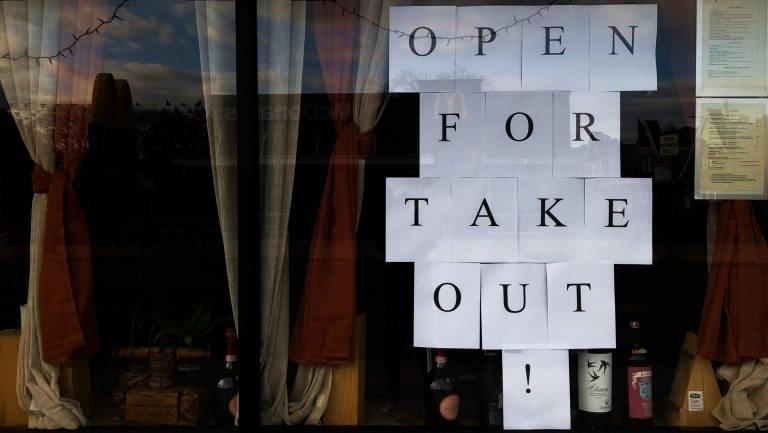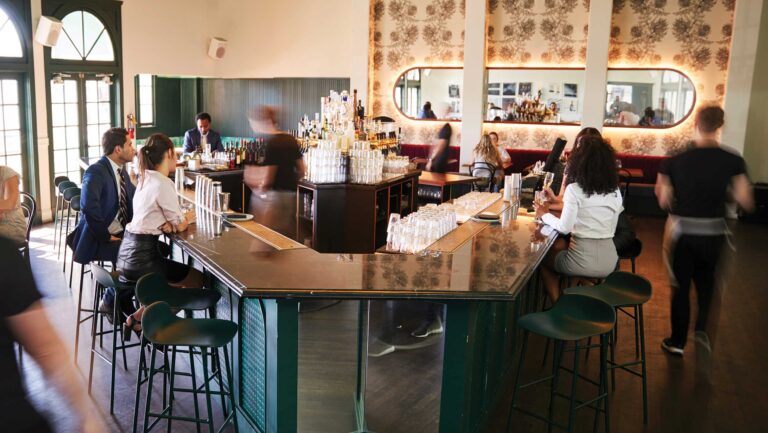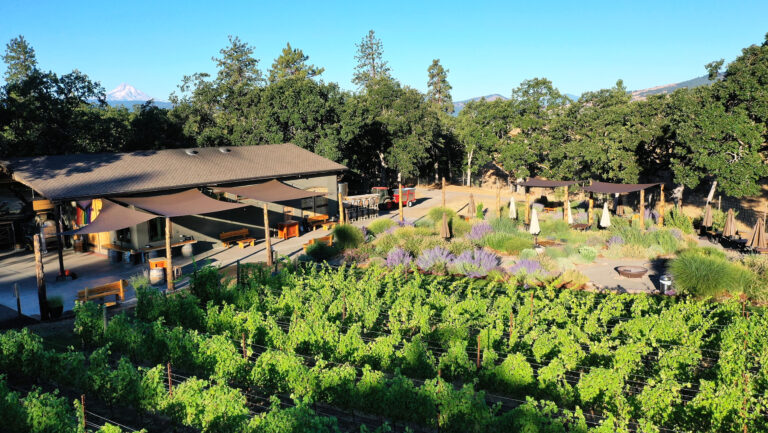In an effort to keep some employees on payroll and stay in business during the coronavirus pandemic, a growing number of restaurants and bars are offering takeout and delivery services for the first time.
Canlis, the acclaimed fine dining restaurant in Seattle, was an early adopter, making the switch on March 12 from its $140 prix fixe menu to $12 burgers to go in order to retain their entire 115-person staff. The menu has since evolved to more elaborate fare, and word has quickly spread that the restaurant is now offering elevated family meals for curbside pickup and “no-contact” delivery—like the Dungeness crab boil offered on March 27—along with sommelier-paired bottles of wine.
“We already have a waitlist 1,000 to 1,700 people long for every night next week,” shares co-owner Brian Canlis. “The enchilada night is the most popular. Clearly people need comfort, but they also need for it to be special. We’ve been getting pictures from guests who dress up, open our box, and then open up our livestream, where we have our in-house piano players performing. They’re recreating Canlis at home and bringing just a moment of joy and delight during this terrible time of uncertainty and stress.”

Don’t miss the latest drinks industry news and insights. Sign up for our award-winning newsletters and get insider intel, resources, and trends delivered to your inbox every week.
As almost every state has mandated restaurants and bars to close, and more than half of all Americans ordered to shelter-in-place, more and more restaurants are trading white table cloths for takeout boxes. Matt Stamp, Master Sommelier and co-owner with Ryan Stetins of Compline Wine Bar in Napa was inspired by Canlis’s model: “My partner and I did the same thing at our wine bar in Napa, and I’m now delivering takeout burgers and duck fat fries because people want comfort right now.”
While switching to takeout won’t enable every restaurant to avoid layoffs, it can provide some financial relief as well as the satisfaction of being able to provide an essential service to the public. SevenFifty Daily spoke with a number of them to learn what works, and what doesn’t.
Understanding the Cost of Delivery Apps
As deliveries through third-party delivery services, such as ChowNow, Seamless, Instacart, GrubHub, Caviar, DoorDash, and UberEats have exploded in recent weeks, it’s tempting for restaurants to want to be part of that marketplace. Yet these services charge restaurants as much as 35 percent per order (which is why David Chang, founder of the Momofuku Restaurant Group, calls this delivery model “fool’s gold”).
Under pressure from mayors in major cities, Seamless, UberEats, and Grubhub have dropped the steep fees for non-chain restaurants during the pandemic. DoorDash and Caviar are waiving commissions for 30 days. While Grubhub is deferring the collection of $100 million in commissions from restaurants, they will eventually collect that money.
The New York City Hospitality Alliance is calling on delivery services to cap their fees at 10 percent, instead of charging or even deferring the charge for 15 to 30 percent they normally charge. Not doing so, the alliance says, would amount to cashing in on an unexpected “windfall during this emergency… We must preserve some profit for restaurants.”
“We experimented with UberEats and a few others, but the 33 percent cut they want is insane,” Stamp says. “It shows a complete lack of understanding about a restaurant’s revenue structure. I’d rather just handle the deliveries myself, even if that means a lower volume.”
Besides, keeping deliveries in-house can mean retaining jobs in-house. “The only way we were able to keep all our people on payroll is by having our own staff do delivery,” says Canlis. The restaurant is currently using 25 drivers to deliver 300 meals a night, and with the move to delivery-only, he hopes to grow that to 40 to 50 drivers delivering 1,000 meals a night.
By shifting front-of-house staff to drivers, Colorado’s Id Est Hospitality Group, with Dry Storage, Basta, Bruto, and Wolf’s Tailor, was able to keep most staff employed. “For weeks, we had been preparing each [restaurant] for a shut-down,” says Colton Steiner, Dry Storage’s head miller. With the move from limited pick-up only to delivery across the board, “we have been able to save a lot of jobs.”
Other operators do use some delivery services, while encouraging customers to order directly as much as possible. Stacey Sosa, who has owned and run the Argentinian fine dining mecca Estancia 460 since 1995 in New York City, was pressured to list with Seamless years ago, in order to retain one of her biggest clients, CitiGroup, when the bank began ordering through that app exclusively. But she incentivizes all customers to order directly through the restaurant to protect profit margins: “We offer customers a 25 percent discount on orders over $40 if they order through us, and for orders over $75 we include a free bottle of wine.”
New emergency SLA rules in some states have made temporary exceptions that allow restaurants to deliver alcohol during the shutdown period, providing a window of opportunity to increase profitability, and get creative. Sosa recently began offering cocktails in coffee cups and happy hour prices from 12 to 7 pm that has led to an impressive “uptick in orders.” Some restaurants are offering bottled cocktails.
Gina Buck, beverage manager and general manager of Concord Hill in Brooklyn, offers 15 percent off all alcohol purchases for customers who order directly, though she does list with GrubHub. “We have to pay $5 for every order delivered through Relay, even if it’s $10, in addition to the 25 percent to GrubHub,” Buck says. “So we do everything we can to encourage people to order through us online directly,” which also allows her to keep a few more of her 15-person staff employed.
Restructuring Menus and Prices
For many fine dining restaurants, the switch to takeout requires a complete menu revamp. At Burke’s Salt & Char in Saratoga Springs, New York, where dine-in patrons typically order $125 seafood towers, market price lobsters, and $90 dry-aged porterhouses, the takeout menu now offers a single 3-course menu for $15 that changes each day. On Thursdays it’s arugula salad, grilled hanger steak, and bread pudding; Saturday, it’s Waldorf salad, prime rib, and chocolate cake.
Canlis has exclusively moved to a delivery-only model during Washington’s shelter-in-place mandate and built out a more elaborate menu: Customers now choose from one main course, then add additional courses, sides, and wine. Prices will start at $35 per person, and go up from there.
At Sushi Ginza Onodera in Los Angeles, the $300 omakase tasting never even had a print menu. “Omakase is up to the chef, and dependent on what fish is available,” a representative for Onodera explains. Initially, Chef Yohei Masuki planned to close for business during the pandemic crisis, but on March 20 decided to adjust his fine dining menu by using the same ingredients, but making it work for takeout (Chirashi—“scattered”—sushi for $150 for example). Beautifully-shot Instagram shots have helped get the word out. (However, the drastic shift proved too difficult to sustain; on March 31 the restaurant closed completely, with plans to reopen in the latter part of April.)
Finding the Right Mix
At restaurants that already leaned toward upscale comfort, like Compline and Estancia, the menus have shifted less dramatically: replacing fish entrees with sturdier proteins and pastas which hold up better while traveling.
In Los Angeles, the Michelin Star-winning Chef Anthony Alaimo’s 101 North Eatery & Bar is also offering a slightly condensed and discounted version of its regular menu. “We want to accommodate the masses and ensure our food is accessible to all during these times,” Alaimo says. The menu is diverse, with $12 short rib sliders and an array of salads and pizzas for $14 to $22, and cumin-rubbed rack of lamb for $31. When Alaimo and his team added alcohol to their menu, he says, “business and revenue picked up.” In addition to beers for $3.50 and up and wines for $15 a bottle and up, they have cocktail kits available. One, the Old Fashioned Kit, includes a bottle of Redemption Bourbon, homemade simple syrups, bitters, and lemon and orange zests for $40.
Yannick Benjamin, who has postponed the opening of his new New York City restaurant, Content, because of the pandemic, is hoping to launch as a delivery-only model to “get us through this dark time,” he explains. “I just met with the chef to discuss options and we had delicate white fish on the menu, but now we’re thinking of pivoting to a focus on pizza, and anything that travels well.”
Managing Sanitation
Minimizing risk for guests and staff in the COVID-19 pandemic means limited contact, prepaying whenever possible, and following Center for Disease Control’s guidelines for restaurants.
“Touchless restaurant experiences are possible, but until now, they haven’t really existed,” says Justin Hill, principal of Seattle-based global retail architecture design company. They are also based in Seattle. MG2. “Interaction still often happens at the time of selection and order, payment, and then at delivery or handoff of service.”
While next-generation technology that relies on voice ordering is in the works, for now restaurants are relying on mobile ordering via an app service or through a restaurant’s website, the utilization of Apple or Google pay, and touchless drop offs (when an order is set out curbside and the customer approaches after the server leaves).
Roslyn Stone, chief operations officer of Zero Hour Health and Get Zedica, both of which were created to help restaurants cope with sanitation issues, explains that the food itself is safe: “There is no evidence that COVID-19 is transmitted via food; this is a person to person illness.”
“We have thought through every step of the process, and now the only contact our staff has with our guests is when they hand them their food,” says Canlis, adding they always wear gloves. Customers can pay by credit card on the spot, but their credit card is the only thing that comes into contact with the scanner; no signature is required. After each transaction, staff wipes every surface with bleach.
Getting the Word Out
Forgoing delivery apps puts the marketing burden on restaurants, but many restaurants are finding that their customers are eager to help spread the word.
Dry Storage’s Steiner is relying on social media as an informal advertising vehicle. “We’ve been using social media to promote our takeout and delivery, and our community has been very helpful in spreading the word on social media themselves,” he says. “This has been a huge learning experience for us, and it has made me realize how much we rely on each other, and our community.” While no one can predict when the shutdown will end, or what the restaurant landscape will look like when it does, one thing is certain: The key ingredient for survival right now is creative flexibility.
Editor’s note: This story has been updated April 2, 2020 to state that Sushi Ginza Onodera has temporarily closed.

Dispatch
Sign up for our award-winning newsletter
Don’t miss the latest drinks industry news and insights—delivered to your inbox every week.
Kathleen Willcox is a journalist who writes about food, wine, beer, and popular culture; her work has appeared in VinePair, Edible Capital District, Bust magazine, and Gastronomica, and on United Stations Radio Networks, among other venues. She recently coauthored, with Tessa Edick, “Hudson Valley Wine: A History of Taste & Terroir.” She lives in Saratoga Springs, New York.







